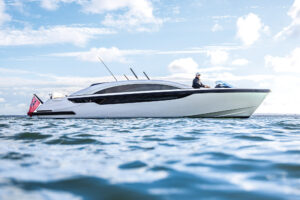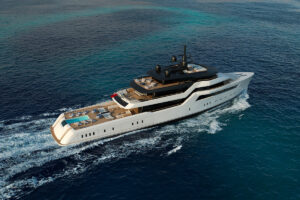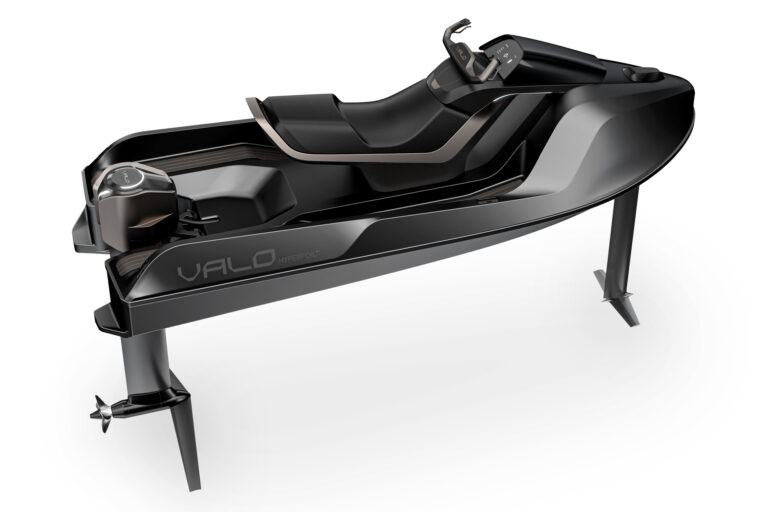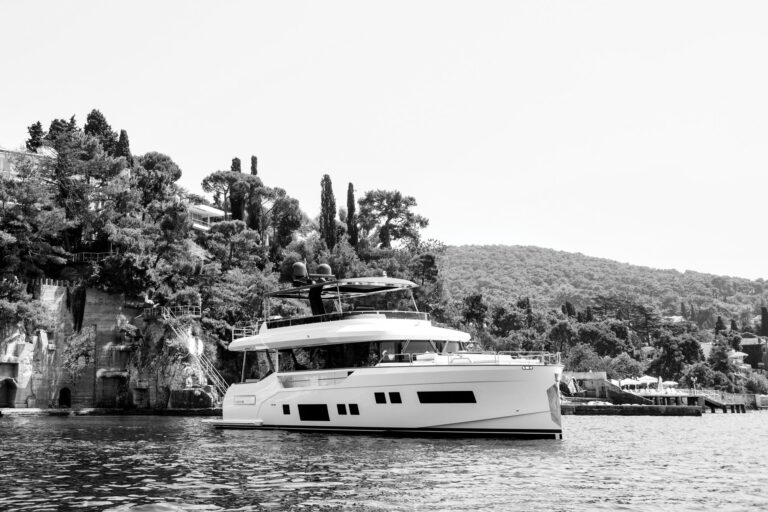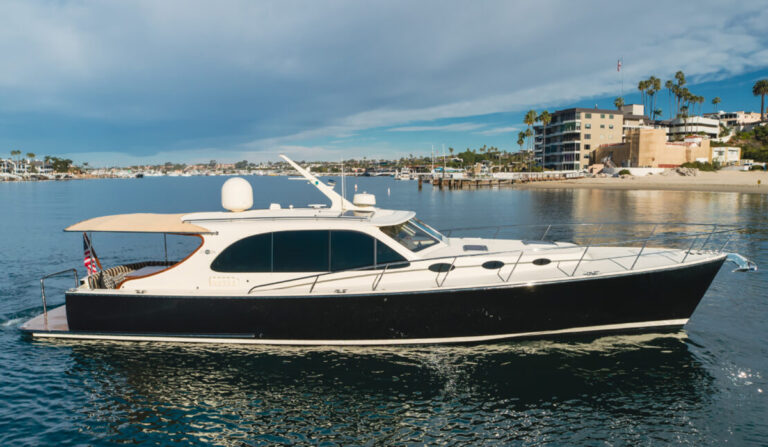
ytgjul08burger126.jpg
As the patriarch of American maritime magazines, Yachting was proud to celebrate its 100th anniversary last year. But Burger Boat Company makes us look wet behind the ears-they were already well established when we published our first issue in 1907. Founded in 1863, the Manitowoc, Wisconsin, boatbuilder is fast approaching its 150th anniversary, yet it continues to grow, evolve, and set new benchmarks. Within the past five years, the company has replaced all of its aging buildings, expanding to better accommodate its order book of larger yachts. Just over a year ago, Burger delivered Mirgab V to a Middle Eastern client. At 144 feet, it was the largest yacht Burger had ever produced.
Now, in another first, Burger has delivered twins, two 126-foot trideck motoryachts for one owner. While the construction of a nearsistership for another buyer is common, the launching of absolutely identical twins by a custom yachtbuilder is virtually unknown. In the case of Areti I and Areti II, the rationale was practicality and logistics. The young Russian owner travels frequently to Europe and to the U.S., so he wanted a yacht available in each area. The obvious solution was to order two, keeping one on America’s East Coast and the other in the Mediterranean.
When Burger delivered the 125-foot Arara (later Kakapo) in the 1970s, she was the largest aluminum yacht in the world. As a protege of her designer, Jack Hargrave, I had a chance to participate in her development, so it is especially interesting for me to compare and contrast her with the Areti sisters some 30 years later.
Though only one foot longer, the new yachts are far, far larger when compared by deck area, volume, and displacement. The Aretis’ beam is nearly two feet wider, and forward, the main-deck house is carried out to the full beam, where Arara had walkaround side decks. Areti I and II are trideck arrangements, while Arara, designed to travel the U.S. inland waterway system with its bridge-height limitations, had only a raised pilothouse, and not raised much, at that.

| | |
Arara carried three guest staterooms plus a convertible guest lounge below deck. The Aretis have four guest staterooms belowdecks plus a master suite on deck.The new yachts also have a full bridge deck that carries a wheelhouse, captain’s cabin, and skylounge, plus an open-top deck with guest amenities including a spa, bar, and dining area.
Fuel capacity on the Aretis is about 30 percent greater, yet the freshwater tankage is less than half of Arara’s, a result of the vastly improved capabilities of today’s watermakers. Both the old and new designs top out at just over 15 knots, but surprisingly, the new yachts, with their signicantly higher displacements, use only 18 percent more horsepower.The difference is modern propeller technology.
Then as now, draft was an issue, and that meant using the highest blade-area propellers to deliver the best efficiency while still minimizing diameter and thus draft.The old yacht spun four-blade Columbian Bronze “Mako” wheels, off-the-shelf workboat props that were not as finely finished as that era’s alternative, Michigan Wheel “DynaQuad” props, but provided a higher blade-area ratio, meaning more square inches of blade surface for a given diameter.
The new yachts run Michigan Wheel props, but rather than DynaQuads, they are semi-custom five-blade wheels that provide both the necessary area and a slimmer, better-finished section shape. The result is vastly improved overall propulsive efficiency, meaning the new boats are carrying a lot more tonnage at the same speed for just a little more fuel burn.
While I don’t have exact figures for this installation, improvements in efficiency, purely as a result of propeller availability and the resulting optimization, have been as much as 30 percent over the 30-year interval between these two Burger deliveries. Add to that the fact that diesel engine technology has also advanced, with modern engines delivering the same power for about 10 percent less fuel burn, and you have a remarkable savings in fuel consumption-maybe not enough to offset the rise in fuel costs, but a significant nod to the wallet and the environment as well.
Another significant difference between the old and new yachts is the layout of the interior arrangement. Where Arara’s guest staterooms were aft of her engineroom, those on the Aretis are amidships, with the engineroom, and its concentrated heft, aft. This shifts the yacht’s center of weight and thus the hull’s center of buoyancy aft, allowing the new wider hulls to have forward hull sections that are just as fine as those of the older, narrower yacht. This keeps the entry angle at the waterline low, and assures a smoother, easier passage in a seaway. It also places the guest staterooms near the center of the yacht, where movement is the least pronounced.
There are four guest staterooms surrounding a central foyer on the lower deck: the after two with queen berths and the forward two with twins. The aft cabins are a bit larger, which means wider berths, larger showers, big hanging lockers, and a small desk for VIP guests. The forward cabins have twin berths, smaller lockers, and smaller showers, though they’re still large enough to include a seat. Off the foyer to port is an over/under washer and dryer (another is in the crew quarters forward), and a Eurocave wine cooler with a 260-bottle capacity. To starboard is a sauna that includes high and low benches, and under the staircase on centerline is a bonded storage locker.

| | |
On the main deck forward is the full-beam master suite with a king berth on centerline, flanked by nightstands and facing a 42-inch LCD video screen.There’s a four-section dresser to starboard and a spacious settee to port, each with three tall windows above to afford the owner an expansive view of the sea.There are separate his-and-hers heads, his with a shower, hers adding a bidet and replacing the shower with a whirlpool tub. The back bulkhead of his head conceals a watertight door that will allow escape from the master suite to the foredeck in the event of an emergency. The design shows emergency contingencies at the aft end of the yacht, as well, where there are two exits from the engineroom and two from the adjoining lazarette.This allows for crew safety, whether the problem is fire, flooding, or simply rough weather.

| | |
The centrally located galley is quite workable with its “semi-island” arrangement, and incorporates a spacious crew lounge forward. Stairs from here to the crew quarters forward, and a door to the side deck and port bulwark gate, assure that crew members will not intrude on guests while performing routine chores.
The salon and dining room exemplify the simple yet elegant decor that provides a neutral backdrop for the owner’s artwork displayed throughout the yacht. The dining room seats the full guest complement of ten, or the table can be shortened to allow more open space when fewer guests are aboard. The salon also seats ten, six on two sofas and the remainder on loose chairs. Theres a 51-inch plasma screen recessed behind a console piano to starboard, as well as a serving bar that has an icemaker and refrigerator built into the base.
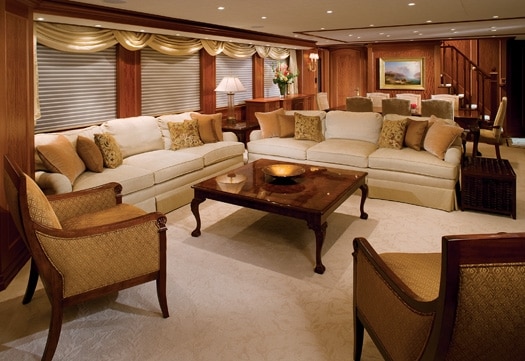
| | |
The skylounge, up one deck, has a larger bar, this one with four comfortable chairs. The space has two sofas, arranged in an L, facing the central entertainment center, which is topped by a 42-inch LCD screen.Theres a day-head in the skylounge, as well as one opposite the galley on the main deck.
Since the bridge deck includes wing controls port and starboard of the wheelhouse, there is no need for a command station on the top deck. A circular hot tub and surrounding sunpads, with weathertight storage below, dominate the forward part of this deck. Amidships is a table for alfresco dining, and a large bar, with a grill to starboard, sits aft. Even here, concern for the safety of the owner, his guests, and crew is evident. Outboard of the bulwarks, from where it is easiest to launch them, are four Viking liferafts in canisters, each with a passenger capacity of twenty. It may seem like overkill for a yacht that carries only ten guests and a crew of ve or six, but it takes into account day cruises with larger parties, as well as situations that prevent the launching of rafts from one side or the other. An emergency at sea is a poor time to ask for swim-team volunteers.
Burgers backlog currently includes a number of custom motoryachts, both larger and smaller than Areti I and II as well as a 151-foot classic fantail cruiser for an experienced American owner. Due to a change in one clients plans, the yard also has a 153-foot trideck available for delivery later this year.
With all of this activity the yard appears poised to keep making history through the next century.
Burger Boat Company, (920) 684-1600; www.burgerboat.com

